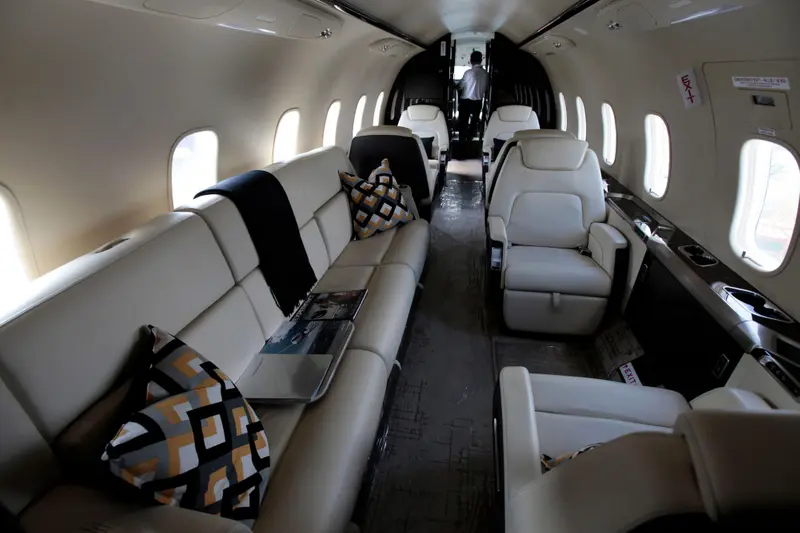Flying to Ireland to inhale the seaside air as you drive a golf ball into the scenic distance. Crossing the country to reach your enormous yacht, which is ready for your Hudson River pleasure cruise. Hosting a governor’s wife on your very own aircraft. These are only a few of the joys that the richest Americans have experienced in recent years through their private jets. And what made them all the sweeter is that they came with a tax write-off.
Over the past two years, ProPublica has documented the many ways that the ultrawealthy avoid taxes. The biggest or most daring maneuvers scale in the billions of dollars, and while the tax deductibility of private jets isn’t the most important feature of U.S. tax law, the fact that billionaires’ luxury rides come with millions in tax savings says a lot about how the system really works.
There are dozens of examples of wealthy Americans taking these sorts of deductions, which are premised on the notion that the planes are used mainly for business, in the massive trove of tax records that have formed the basis for ProPublica’s “Secret IRS Files” series. The ultrawealthy, however, can easily blur business and pleasure. And when they purport to make their planes available for leasing, to fulfill one definition of using the planes for business, they tend to be more adept at generating tax deductions than revenue.

Tony Alvarez and Bryan Marsal built a successful consulting firm specializing in restructuring — advising struggling or bankrupt companies on what to sell and whom to lay off. It can be a grim business: Marsal has been known to announce to prone firms that they were now a “community of pain.” But the partners, who are also close friends, own another enterprise, the Hogs Head Golf Club (“Built by Friends, for Friends, for Fun”), on the southwest coast of Ireland. It boasts views of the nearby mountains and bay.
In 2016, before opening their new course, the pair teamed up, via an LLC they named after their golf club, to buy a 2001 Gulfstream IV jet. The next year, President Donald Trump signed his big tax cut into law. It made buying a plane even more attractive: The full price of the plane could be deducted in the first year, a perk called “bonus depreciation.” Before, depreciation was typically only partially front-loaded, with the full balance spread over five years. The law also for the first time made pre-owned planes eligible for this treatment.
As a result, when Alvarez and Marsal sprang for their second plane in 2018, this one a Gulfstream V, the entire cost was deductible. That year, the pair’s two planes netted them a tax deduction of $14 million.

Last August, their Gulfstream V took off from Westchester County Airport in New York state for Ireland. About an hour later, their Gulfstream IV left for the same destination, a small airport in County Kerry near their club. Both planes can comfortably seat over a dozen passengers, but flight records don’t show who was on board. Over the coming month and a half, the two planes crisscrossed the Atlantic several times.
Were these business trips? Possibly, yes. (ProPublica’s records do not indicate whether specific trips were taken as deductions.) If so, operating expenses — including crew, fuel and other costs — from the partners’ trips to oversee the course would be fully deductible. These deductions would come in addition to depreciation.
Michael Kosnitzky, co-chair of the private client and family office group at the law firm Pillsbury Winthrop, said his wealthy clients often own a business, such as an art gallery, in the same area where they own a vacation home. If the main purpose of a flight there is to attend to that business, jet owners must take care to make that as clear as possible. “I advise my clients to go to their secondary business location first” upon landing, he said, as a way to help build the case.
Accounting for how a jet is used can get complicated. If nonbusiness guests, such as family, ride along on a business flight, it’s treated as a fringe benefit, which is taxable. (The benefit is typically attributed to the jet owner, experts said.) But that wrinkle isn’t too bad: The IRS formula used to calculate the benefit drastically undervalues the cost of riding on a private jet and is closer to the price of a first-class commercial ticket.
Last Christmas, flight records show the two Gulfstreams again leaving together, this time to St. Vincent and the Grenadines in the Caribbean. While Alvarez and Marsal’s consulting firm boasts an office in the Cayman Islands, there isn’t one on these particular islands (which are about 1,400 miles from the Caymans), making it appear this was a family trip. Operating costs from “entertainment” flights like these are not deductible under tax law. But indulging in some pleasure doesn’t necessarily imperil the key tax prize of bonus depreciation: As long as, over the course of a year, the jet is used over 50% of the time for business, the owner gets to keep that perk.
A spokesperson for Alvarez and Marsal’s firm did not respond to a request for comment.
Mori Hosseini made his fortune as a Florida homebuilder and has owned a plane since at least 2006. When Trump’s tax bill began to gain momentum in Congress in the fall of 2017, he decided it was time for a new jet.
The $19.5 million he paid for his nine-seat Bombardier Challenger 350 appeared as a deduction on his 2017 taxes, leading to almost $8 million in tax savings right off the bat. But there were more deductions to come. Even the interest on the loan he’d taken out to buy the plane was deductible, and his 2018 taxes show a $600,000 expense.
Soon, Hosseini, a longtime Republican donor and close adviser to Florida Gov. Ron DeSantis, was helping the governor and his family travel in style. In 2019, DeSantis’ wife, Casey, flew on the jet from Tallahassee to Jacksonville to attend a fundraiser held by a defense contractor. It was just one of several times that the DeSantises or the campaign have used the jet over the past few years, according to campaign finance records. Such flights are generally allowed under Florida law as long as they are disclosed as in-kind contributions. Hosseini did not respond to questions from ProPublica.

On his taxes, Hosseini says the LLC that holds his plane is in the business of “aircraft leasing.” It’s a very common move among jet owners. When they are not using the plane, they rent out the plane for charter flights, usually via an independent leasing company. Not only does this defray the costs of ownership, but it has tax benefits, too. It helps them establish that they bought the aircraft for a business purpose, the business of chartering.
In theory, taxpayers aren’t allowed to deduct losses from something that has no hope of being a profitable business. In practice, though, some billionaire-owned operations that look like expensive hobbies, such as racing horses in the Kentucky Derby, rack up business deductions by the tens of millions of dollars.
ProPublica examined the tax records of over 30 wealthy Americans who owned planes, and one thing was very clear: Profits in the airplane chartering business for this set, judging from their taxes, were extremely rare. Hosseini's records show two years of profit over an eleven-year period.
Or take George Argyros, a California billionaire real estate developer who once owned the Seattle Mariners. A major GOP donor, he also was the U.S. ambassador to Spain from 2001 to 2004. Argyros, 86, has leased out his aircraft through his own chartering company for decades. From 2002 through 2019, his tax records show, his company pulled a profit just twice. Overall, he deducted over $50 million in net losses over the years.
In June 2021, Argyros’ Gulfstream landed at the small airport near Newburgh in New York’s Hudson Valley, having flown cross-country from California. Nearby, his $83 million, 248-foot yacht the Huntress awaited. Over the coming weeks, the ship would be seen cruising up and down the Hudson River, astounding locals who gawked at its six decks, helipad and hot tub.

A representative for Argyros declined to comment.
Yachts are dealt with differently from airplanes in tax law. They are considered entertainment facilities, so you can’t claim deductions on the premise that you used it for business travel.
But that doesn’t mean there’s no tax savings to be had. Mike Fernandez is a capable businessman, having made a fortune starting and investing in health care companies. But the Florida-based investor seems to have abysmal luck with one of his businesses: leasing out his 180-foot yacht, the Lady Michelle, when he’s not using it. On his 2017 and 2018 tax returns, he claimed a total of $11.3 million in expenses connected with the Lady Michelle from depreciation, repairs, wages and other costs. Meanwhile, his revenue over the two years totaled $178,000. Fernandez did not respond to questions from ProPublica.
Should the IRS audit one of these businesses — itself unlikely over the past decade, due to the gutting of the agency’s budget — the IRS faces a high hurdle: proving that not only was the business not profitable, but that the business owner was not really trying to profit. The case of personal jets adds an additional difficulty for an auditor. The ultrawealthy can often argue that, even if chartering did not result in profits, they also used the plane to help conduct their main business.
Robert Bigelow made his fortune in real estate and owns Budget Suites of America, an extended-stay apartment chain. His passions, however, reach to the skies and beyond. For decades, he’s poured resources into investigating UFO sightings and paranormal phenomena. Two years ago, he announced $1 million in grants from his Bigelow Institute for Consciousness Studies for research “into contact and communication with post-mortem or discarnate consciousness.”

His main focus, however, has been space. He founded Bigelow Aerospace, a company focused on building expandable space habitats. The company has had some successes, winning a contract from NASA for a module for use on the International Space Station. But what it has not had is profits. Bigelow put more than $350 million into the company, “my own real black hole,” as he’s put it.
In the two decades prior to 2018, even as Forbes and The Wall Street Journal variously estimated his net worth as $700 million and $900 million, Bigelow posted negative incomes on his taxes most years, as large losses from his aerospace company wiped out his other income. His personal jet, held by Cosmos Air LLC, also played a role. From 2005 to 2018, he deducted a total of $51 million related to use of his plane. ProPublica could not find evidence that Bigelow charters his aircraft, nor did Bigelow respond to ProPublica’s requests for comment.
Of course, the deductions could also be justified on the basis that the aircraft is necessary to tend to Bigelow’s various businesses. The plane is a luxury expense, in other words, essential to help him run up millions more in tax deductions — one black hole orbiting another.
Jeff Ernsthausen contributed reporting.












